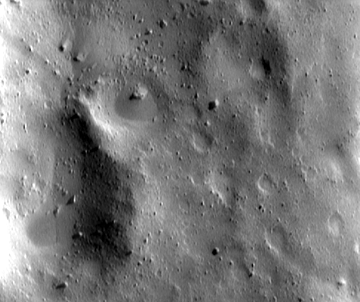Cornell cosmologist Thomas Gold revives old debate about moon to explain movement of dust into craters of asteroid Eros
By David Brand

More than just dust was kicked up when NASA's Near Earth Asteroid Rendezvous spacecraft, NEAR Shoemaker, made a successful landing on asteroid 433 Eros on Feb. 12. Also disturbed were the memories of an experiment carried out more than three decades ago by a student of Thomas Gold, professor emeritus of astronomy at Cornell University.
Images of small craters on 22-mile-long Eros, sent back to Earth by the NEAR spacecraft's camera, revealed a fine-grain material that has somehow found its way to the bottom of the craters. The members of the NEAR imaging team, including the team's leader, Cornell astronomer Joseph Veverka, expressed puzzlement over the movement of the dust that had created flat, smooth floors in craters. There is, they said, some unknown mechanism that moves the dust around so that it slides down the craters' sides, "ponding" in the bottoms.
Gold was, perhaps, the only observer not surprised. Static electricity, he argues, causes dust grains to levitate downhill into the bottom of craters -- the same process, he believes, that has filled craters on the moon. "If you added a layer 1 micron [0.001 millimeters] thick in the time since the Pyramids were built [about 5,000 years ago], you could get a layer 1 kilometer in depth over a billion years," says Gold, who has long been known as one of the world's foremost cosmologists.
"The features on Eros are so similar to those on the moon, that dust levitation has now to be reconsidered for all large lunar features, and major conclusions of lunar research now have to be reconsidered," says Gold.
Electric charges on the grains, he says, were created by charged-particle bombardment from the sun's solar wind, a current of ionized atoms and particles such as electrons and protons that the sun spews from its surface. When electrons with a high enough energy hit the dust grains, they either cause the grains to gain more negative charge or more positive charge, depending on the substance. "It's a very intriguing possibility and one which we will be evaluating seriously during the coming months," says Veverka, who is chair of Cornell's astronomy department.
Gold's controversial theory dates back to stormy debates that continued through the 1950s into the early 1970s on the geology of the moon's impact craters and their flat, dust-filled floors. Gold himself had written his first paper on the subject in 1955. And in the late 1960s his graduate student, the late Gregory J. Williams, carried out research at Cornell's astronomy department, which Gold chaired from 1959 to 1968, into the electrostatic agitation of the surface layers of fine rock powders. In 1976, Williams' Ph.D. dissertation, Electrodynamics and the Moon -- Transport Mechanisms , expounded many of Gold's theories on the transportation of dust on the moon.

The laboratory experiments found that dust particles under lunar conditions move when different grains adopt very different charges. The electrical interaction sets up strong electric fields on a very small scale, allowing electrical forces to levitate and move the dust particles.
"Based on the details of reflection of sunlight, grains on the surface had to be small enough so they could pile on top of each other in a very loose formation, which my colleagues called 'fairy castle structures.' I can't understand any process that could occur on the moon that would lift up material the size of a brick, but I can understand processes that would lift up 50-micron-sized grains," says Gold.
This contradicted the view of many geologists, who believed that lunar craters typically were filled either by material ejected by meteoroid and asteroid impacts or by lava. However, says Gold, the smoothing and filling in of craters on the moon and asteroid Eros was not accomplished by falling debris from an impact (which would give a "snowed over" appearance to the land and rocks) -- and lava flows on tiny Eros are not possible.
"The amount of material that is missing from the craters on the side of the moon visible from Earth, if distributed all over that area, would make a layer between one and two kilometers deep. You either have to say that this material vanished from the moon, which is not likely, or that it had migrated downhill just as it would have done on Earth for different reasons," says Gold.
The filling in of craters from dust levitation on Eros appears to Gold to be similar in nature -- and to be taking place at about the same rate -- to the erosion present on the hidden side of the moon, which does not receive as intense an electron bombardment from the solar wind as does the side facing Earth. Since Eros lies 289 million miles from the sun, it is hit by fewer higher energy electrons than the facing side of the moon.
Related World Wide Web sites: The following sites provide additional information on this news release. Some might not be part of the Cornell University community, and Cornell has no control over their content or availability.
o Near Earth Asteroid Rendezvous Mission: http://near.jhuapl.edu/
Media Contact
Get Cornell news delivered right to your inbox.
Subscribe